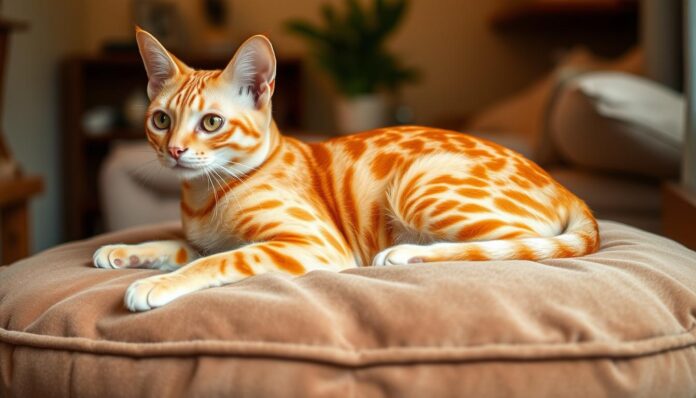Imagine your pet jumping over furniture like a jungle creature. Yet, they can curl up in your lap as softly as any housecat. That’s the magic of the Cheetoh cat. This breed has a wild coat and a soft heart. If you dream of an exotic yet loving pet, the Cheetoh might be perfect for you.
In 2003, breeder Carol Drymon created the Cheetoh cat. It mixes the Ocicat’s elegance with the Bengal’s bold patterns. Their leaps, reaching up to eight feet, show their wild spirit. But they also love to be close to humans, not alone.
These cats are more than just looks. They play at dawn and dusk, and they’re loyal. Their 65 kHz hearing and dog-like tricks make them special. The Cheetoh is a mix of wild and warm, ready to be part of your family.
What Makes the Cheetoh Cat an Exotic Companion
Imagine a cat that looks like a wild animal but acts like a pet. The Cheetoh cat is a unique breed. They have a short, shiny coat with cool patterns like brown spots or blue swirls. But don’t worry, they’re not wild. They’re 8 generations away from their wild ancestors, making them safe and friendly.
What makes Cheetoh cats special:
- They have cool coat patterns that look like wild cats.
- They are very affectionate, even though they look wild.
- They are smart and can learn tricks.
- They don’t shed much, which is good for people with allergies.
| Aspect | Details |
|---|---|
| Coat | Short-haired, with spotted or marbled patterns |
| Temperament | Curious, vocal, and people-oriented |
| Activity Needs | Hourly play sessions daily |
| Health | Potential for heart health monitoring |
Even though they’re rare, their friendly nature makes them perfect for active homes. With the right care, they become loving pets that mix wild beauty with home charm.
The Fascinating Origins of the Cheetoh Cat Breed
Carol Drymon started the Cheetoh cat breed in 2001. By 2003, the first litters were born. They mixed the Bengal’s wild spots with the Ocicat’s friendly nature. This created a designer cat breed that looks great and is good with families.
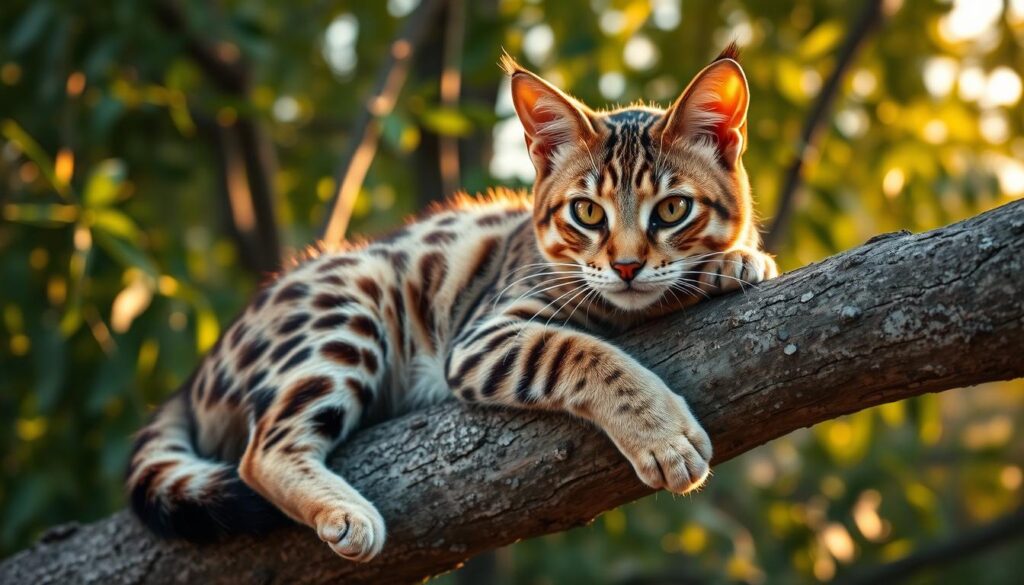
The Bengal and Ocicat Connection
Bengals come from Asian leopard cats, known for their spots. Ocicats, on the other hand, are a mix of Abyssinians and Siamese. They are playful and loyal, like dogs. These two breeds combined to make the Cheetoh’s special traits.
How Designer Breeding Created This Hybrid Wonder
Carol Drymon aimed to mix beauty with a good personality. After many generations, the Cheetoh became eight generations away from wild cats. Now, it has a cheetah-like coat but is as gentle as a house cat.
The Breed’s Development Timeline
- 2001: Carol Drymon starts mixing Bengals and Ocicats.
- 2003: The first Cheetoh kittens are born, with their unique spotted coats.
- 2004: The United Feline Organization recognizes them in experimental status.
- 2005: TICA adds them to their Experimental New Breed Registry.
Today, the Cheetoh is a rare hybrid cat breed. It’s loved for its exotic looks and how well it fits into home life.
Physical Characteristics of Cheetoh Cats
The cheetoh cat characteristics are truly eye-catching. They mix the grace of wild cats with the friendliness of pets. Let’s explore what makes their appearance so unique.
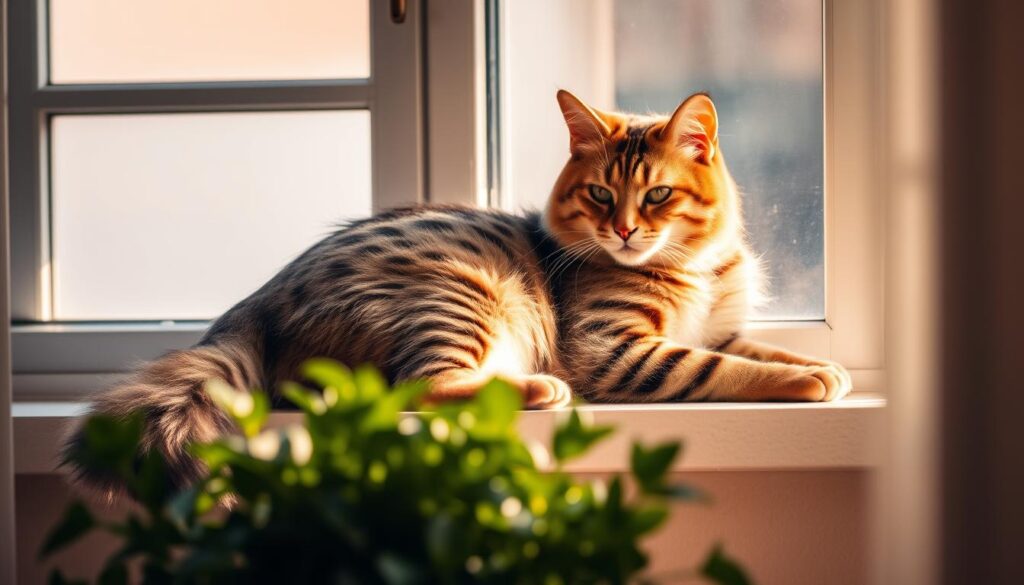
Distinctive Spotted Coat Patterns
Each Cheetoh has a coat that’s a work of art. Their fur shows off bold spots, rosettes, or marbled patterns. You’ll see colors like tawny brown, cool silver, or frosty snow. Some even have a “glitter” effect, adding a shimmer to their fur.
Size and Build: Why They’re Considered a Large Cat Breed
Cheetohs are a large cat breed. They grow 12–18 inches tall and weigh 12–25 pounds. Their strong body and long legs make them look athletic. This sets them apart from smaller domestic cats.
Color Variations You’ll Encounter
- Brown spotted: Earthy tones mimicking jungle patterns
- Silver marbled: Sleek gray swirls over a lighter base
- Snow varieties: Cream or white coats with pale markings
Unique Physical Features That Set Them Apart
Take a closer look at their chiseled faces and almond-shaped eyes. Their tapered tails and high-set ears add to their wildcat look. Their large paws are perfect for climbing and jumping.
The Playful and Affectionate Temperament You’ll Adore
Cheetoh cats are not just beautiful to look at. They also have a personality that wins hearts. As a cheetoh cat owner, you’ll see their dog-like loyalty. They follow you everywhere and answer when called.
This breed loves to be around people. Even simple things like eating become fun moments for them.
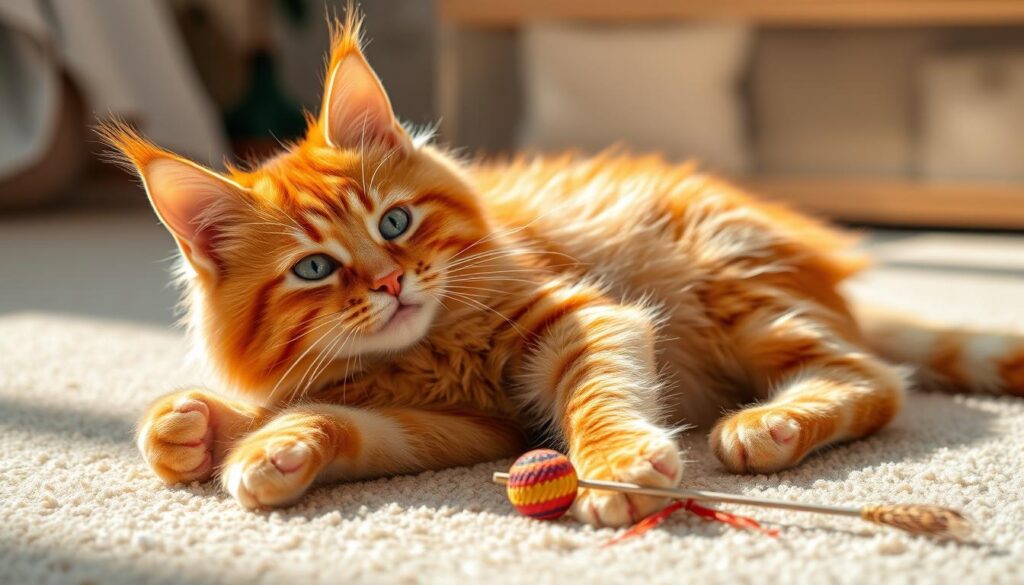
- High Energy Playfulness: They never get tired of playing with toys. They’ll play fetch, chase, and games for hours.
- Vocal Communication: They talk a lot, using chirps and meows to show their needs or curiosity.
- Family-Oriented: Cheetohs love everyone in the house, including kids and pets, if they’re socialized early.
This cat breed information shows they need to be part of your life. They don’t like being ignored and might get anxious if left alone. They love to explore, so cat trees and puzzle toys are a must.
They’re like social butterflies, welcoming visitors at the door. Their loving nature means they’ll ask for pets or snuggle in your lap. They bring joy and warmth to any home, whether you’re working or relaxing.
Caring for Your Cheetoh Cat: Essential Guidelines
Proper cheetoh cat care is key for your cat’s well-being. These cats, known for their unique cat breed information, require special care. They need a diet rich in animal protein, just like their wild ancestors.
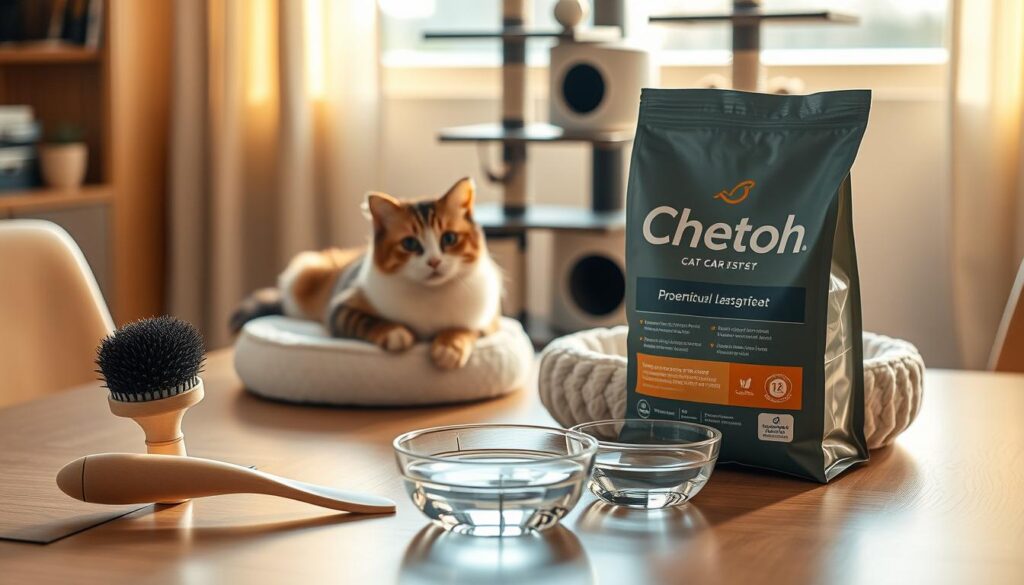
Dietary Requirements for Optimal Health
Choose high-quality food with real meat as the first ingredient. Feed them 3-4 small meals a day. Each meal should be ¼ to ½ cup of dry food or 3-5 oz of wet food.
Make sure they always have fresh water. Aim for 4 oz of water per 5 lbs of body weight. Avoid grains and choose recipes with taurine and omega-3s for their heart and coat health.
Grooming Needs and Techniques
- Brush weekly to reduce shedding and distribute natural oils.
- Trim nails every 2-3 weeks to prevent overgrowth.
- Clean teeth 3-4 times weekly with vet-approved products.
Exercise and Enrichment Activities They Crave
These cats need 30-60 minutes of play daily. Use toys that mimic prey, like feather wands or laser pointers. Consider leash walks or puzzle feeders to challenge their intelligence.
Socialize kittens early with people and pets. They need 10+ interactions before 12 weeks for calm adulthood.
Creating the Perfect Living Environment
Provide at least 400 sq ft of space. Install tall cat trees, window perches, and shelves for climbing. Maintain indoor temps between 65-75°F.
Use litter boxes sized 24×18 inches—one per cat plus one extra. Regular vet visits every 6-12 months ensure early health detection.
Common Health Considerations for Cheetoh Cats
As a Cheetoh cat owner, it’s important to know about their health needs. This ensures they live a long, happy life. Proper cheetoh cat care means knowing about inherited risks and regular vet visits. Let’s look at how to keep your cat healthy with the latest cat breed information.
Genetic Health Issues to Watch For
Cheetoh cats may have traits from their Bengal and Ocicat parents. Key concerns include:
- Hypertrophic Cardiomyopathy (HCM): This heart condition can be caught early with heart scans. Early detection helps a lot.
- Patellar Luxation: Loose kneecaps can cause limping. Regular vet visits help track joint health.
- Eye Conditions: PRA and cataracts can affect vision. Genetic testing is needed for breeders.
Recommended Veterinary Screening
Annual checkups should include:
- Heart Exams: Yearly echocardiograms to check for HCM.
- Eye Tests: Genetic screening for PRA and cataracts starts at 8 weeks.
- Dental Care: 50% of cats over 4 have dental disease. Clean teeth twice yearly and get professional cleanings.
Senior cats (over 10) need vet visits every six months to track age-related changes.
Typical Lifespan and Aging Considerations
| Lifespan | 10–15 years with proper care |
|---|---|
| Senior Care Tips | Adjust diets to low-sodium formulas, provide orthopedic beds, and increase vet screenings for kidney issues |
| Common Senior Issues | Arthritis, kidney disease, and hyperthyroidism |
Watch for signs of aging like reduced activity or appetite changes. Early interventions can improve quality of life.
What to Expect When Adopting This Unique Cat Breed
Adopting a Cheetoh cat is a rewarding journey that requires careful preparation. These cats are a mix of Bengal and Ocicat. They have wild patterns but a domestic temperament. Prices start at $500 and can go up to $2,400, depending on the breeder and kitten quality. Before adopting, consider these key factors:
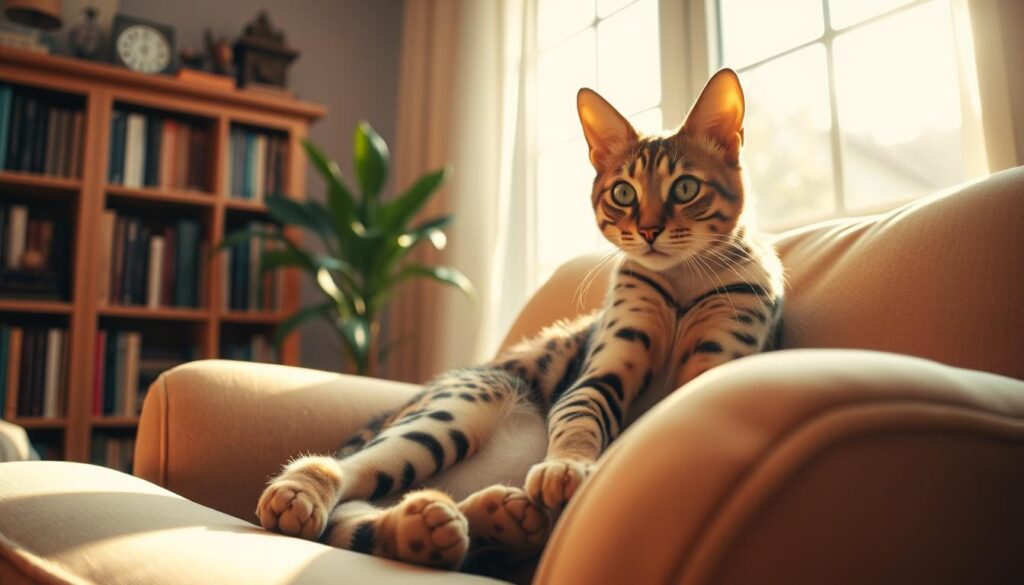
- Breeder research: Look for breeders registered with TICA or UFO. Ask for health clearances and see the parents’ temperaments.
- Legal checks: Check local laws—states like California and Hawaii have restrictions. Licenses may cost $200–$500 annually.
- Home prep: Make sure you have vertical space (cat trees, shelves) and a litter area. Install childproof locks to prevent escape.
A Cheetoh cat takes 2–4 weeks to adjust. Kittens may hide at first but will thrive with patience. Use pheromone diffusers to reduce stress. Compare costs and care needs with similar breeds:
| Breed | Price Range | Space Needed | Special Care |
|---|---|---|---|
| Cheetoh | $500–$2,400 | 1,000+ sq ft | Weekly brushing, high perches |
| Bengal | $800–$3,000 | 800+ sq ft | Interactive toys, cardiac screenings |
| Serval | $1,700–$3,000 | 2,000+ sq ft | Wild diet, legal permits |
Regular vet visits are vital—find clinics experienced with exotic breeds. Socialize kittens early with puzzle toys and supervised outdoor time. With proper care, your cheetoh cat will bond deeply, rewarding your efforts with playful companionship.
Is the Cheetoh Cat the Right Companion for Your Lifestyle?
Choosing the exotic cat breed known as the Cheetoh needs careful thought. You must consider your daily life and home. These cats do well in homes where they get lots of play and space to roam. Make sure their needs match your lifestyle before deciding.
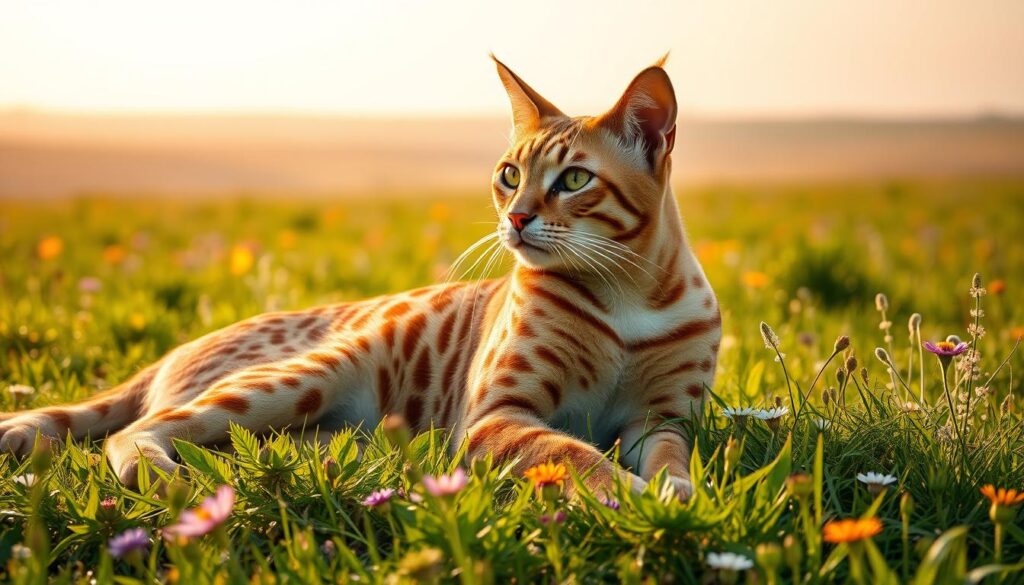
- Activity Level: Cheetohs need at least 30 minutes of play each day. They are very active, jumping up to 8 feet high. This is much higher than most domestic cats.
- Social Needs: They love being around people and can get stressed if left alone for more than 4 hours. About 70% of owners say they are very attached to their cats.
- Living Space: Apartments can work if they have places to climb. They have a short coat that doesn’t need much grooming. But, they do need toys that challenge their minds.
| Breed | Activity Needs | Grooming | Compatibility |
|---|---|---|---|
| Cheetoh | High (30+ mins daily) | Low | Families, active owners |
| Bengal | High | Low | Active households |
| Ragdoll | Moderate | Low | Calmer environments |
If you have time for play and socializing, the Cheetoh is a good match. They form strong bonds and often greet you with slow blinks or headbutts. But, they don’t do well if left alone for long periods without someone to care for them.
Do your homework on cat breed information. They live for 12-15 years, so it’s a big commitment. Ask yourself: Do you have time for daily play, space for their energy, and patience for their curious nature? If yes, the Cheetoh’s unique mix of Bengal and Ocicat traits might be perfect for you.
Conclusion: Embracing the Joy of Cheetoh Cat Ownership
The Cheetoh cat is a unique breed that combines wild beauty with domestic warmth. They are playful and curious, often enjoying leash walks or tricks. This makes them stand out and form deep bonds with their families.
But owning a Cheetoh requires dedication. They need daily play and mental challenges to stay happy. Regular vet visits and a good diet help them live up to 15 years or more. With the right care, they become loyal companions for active families.
Thinking of getting a pet? The Cheetoh is a great choice for those willing to commit. They have a low-shedding coat and are friendly, fitting well into many homes. Remember, they need daily interaction and a safe place to play outside. This ensures a happy life together. Share your experiences and ask questions to connect with other Cheetoh lovers.
FAQ
What is a Cheetoh cat?
The Cheetoh cat is a special mix of wild and domestic cats. They have striking spotted coats and are very loving. This makes them stand out.
How did the Cheetoh cat breed originate?
The Cheetoh cat came from mixing Bengal and Ocicat cats. This was done by Carol Drymon in 2003. She wanted to create cats that look wild but are gentle.
What kind of care do Cheetoh cats require?
Cheetoh cats need good food rich in protein and lots of grooming. They also need lots of exercise and play to keep them happy and healthy.
How large do Cheetoh cats get?
Cheetoh cats are big, weighing 15-25 pounds and standing 10-16 inches tall. Their strong muscles make them look even more wild.
Are Cheetoh cats good with children and other pets?
Yes, Cheetoh cats are very friendly and social. They get along well with kids and other pets if they are socialized right. They love to join in family fun.
What health issues should I be aware of with Cheetoh cats?
Cheetoh cats are usually healthy but might get some health problems from their parents. These include heart issues and knee problems. Good breeding helps avoid these.
How long do Cheetoh cats typically live?
Cheetoh cats live about 10-15 years. Taking good care of them and seeing the vet regularly helps them stay healthy.
What should I consider before adopting a Cheetoh cat?
Think about your lifestyle and home before getting a Cheetoh cat. They are smart and active, so they need lots of play and attention.
What makes Cheetoh cats different from other cat breeds?
Cheetoh cats are special because they look like wild cats but are very loving. Their unique spots and friendly nature make them unique in the cat world.


